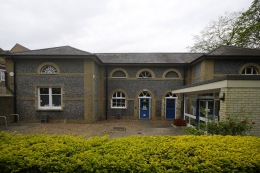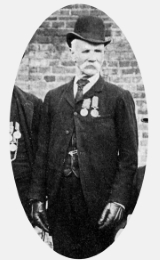Just Holt Articles
This is a small series of articles by Steve Benson (chairman of the society) for Just Holt magazine. The colour photos are by Rodney Smith, Photographers' Gallery, Holt.
Mr Olley's Stables
There are many handsome Georgian buildings in Holt. In fact most of those fronting the Market Place and the High Street are Grade 2 listed and all (or almost all) because they were erected in the aftermath of the Great Fire of Holt in 1708 which destroyed much of the town.

One such building is Wansbeck House, hidden from view by a row of later shops along White Lion Street. For those of an architectural mind set this house is 18th century, plastered and colourwashed, with hipped roof, sashes with glazing bars and a bay window at the South-east corner. The gardens, now hidden or built upon along Church Street, then stretched as far as the churchyard.
Probably a little time later fine stables were built for the House with a yard for carriages. The stables and accompanying street wall are constructed of traditional close-laid small flints of matching size - an attractive style used elsewhere in the town.
So far so pretty, but unexceptional. Now comes the story.
In 1888 a farm labourer's son born in Hanworth 55 years before came to Holt. He had joined up as a cavalry trooper, had been sent to fight the Russians in the Crimean war in 1854 and had charged with the Light Brigade down the Valley of Death at the battle of Balaclava.

James Olley had been wounded five times in the battle and had lost his left eye. His horse had been killed but he had remounted a stray. He had survived, been nursed by Florence Nightingale, and had been invalided home and out of the army. By 1888, unable to work through ill-health, he had been rescued by public subscription from the probable ignominy of ending with his family in the Workhouse. He was set up in Holt first as a pub landlord and then as a horse trainer. Wansbeck House provided his stables.
Olley was quite a character and quickly made a name for himself locally. The survivors of the Charge had by this time become national celebrities and Olley was not averse to taking advantage of this. After a colourful decade, he moved to Blakeney and then to Salthouse where he became, somewhat surprisingly, a churchwarden. He died aged 87 in his own home, Balaclava Cottage, in Elsing near Dereham and was buried in the churchyard with full military honours. He was the last Norfolk survivor of the Charge of the Light Brigade.
Next time you go to Holt library, which now, with suitable modernisation, occupies the stables, look for his framed photograph on the wall. Norfolk's great hero is Horatio Nelson. I like to think that James Olley, in his own small way, is another.

